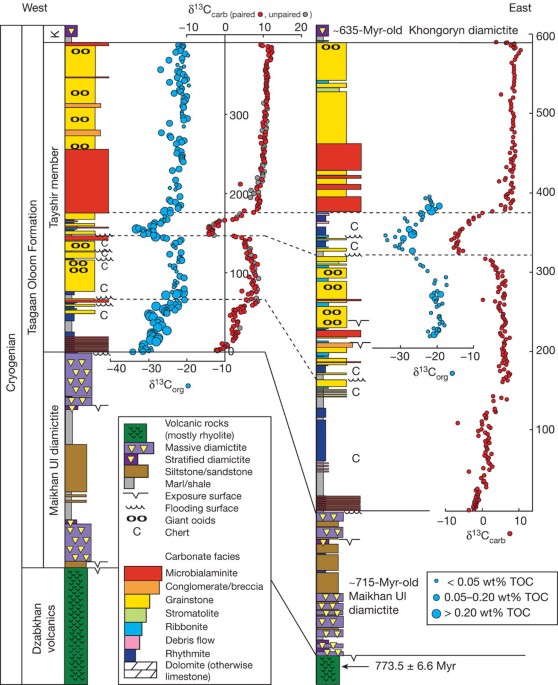
- Select a language for the TTS:
- UK English Female
- UK English Male
- US English Female
- US English Male
- Australian Female
- Australian Male
- Language selected: (auto detect) - EN
Play all audios:
ABSTRACT Interpretations of major climatic and biological events in Earth history are, in large part, derived from the stable carbon isotope records of carbonate rocks and sedimentary
organic matter1,2. Neoproterozoic carbonate records contain unusual and large negative isotopic anomalies within long periods (10–100 million years) characterized by δ13C in carbonate
(δ13Ccarb) enriched to more than +5 per mil. Classically, δ13Ccarb is interpreted as a metric of the relative fraction of carbon buried as organic matter in marine sediments2,3,4, which can
be linked to oxygen accumulation through the stoichiometry of primary production3,5. If a change in the isotopic composition of marine dissolved inorganic carbon is responsible for these
excursions, it is expected that records of δ13Ccarb and δ13C in organic carbon (δ13Corg) will covary, offset by the fractionation imparted by primary production5. The documentation of
several Neoproterozoic δ13Ccarb excursions that are decoupled from δ13Corg, however, indicates that other mechanisms6,7,8 may account for these excursions. Here we present δ13C data from
Mongolia, northwest Canada and Namibia that capture multiple large-amplitude (over 10 per mil) negative carbon isotope anomalies, and use these data in a new quantitative mixing model to
examine the behaviour of the Neoproterozoic carbon cycle. We find that carbonate and organic carbon isotope data from Mongolia and Canada are tightly coupled through multiple δ13Ccarb
excursions, quantitatively ruling out previously suggested alternative explanations, such as diagenesis7,8 or the presence and terminal oxidation of a large marine dissolved organic carbon
reservoir6. Our data from Namibia, which do not record isotopic covariance, can be explained by simple mixing with a detrital flux of organic matter. We thus interpret δ13Ccarb anomalies as
recording a primary perturbation to the surface carbon cycle. This interpretation requires the revisiting of models linking drastic isotope excursions to deep ocean oxygenation and the
opening of environments capable of supporting animals9,10,11. Access through your institution Buy or subscribe This is a preview of subscription content, access via your institution ACCESS
OPTIONS Access through your institution Subscribe to this journal Receive 51 print issues and online access $199.00 per year only $3.90 per issue Learn more Buy this article * Purchase on
SpringerLink * Instant access to full article PDF Buy now Prices may be subject to local taxes which are calculated during checkout ADDITIONAL ACCESS OPTIONS: * Log in * Learn about
institutional subscriptions * Read our FAQs * Contact customer support SIMILAR CONTENT BEING VIEWED BY OTHERS OCEAN TEMPERATURES THROUGH THE PHANEROZOIC REASSESSED Article Open access 27 May
2022 MULTIPLE CARBON CYCLE MECHANISMS ASSOCIATED WITH THE GLACIATION OF MARINE ISOTOPE STAGE 4 Article Open access 16 September 2022 EOCENE MAAR SEDIMENTS RECORD WARMING OF UP TO 3.5 °C
DURING A HYPERTHERMAL EVENT 47.2 MILLION YEARS AGO Article Open access 29 August 2024 REFERENCES * Halverson, G. P., Wade, B. P., Hurtgen, M. T. & Barovich, K. M. Neoproterozoic
chemostratigraphy. _Precambr. Res._ 182, 337–350 (2010) Article ADS CAS Google Scholar * Knoll, A. H., Hayes, J. M., Kaufman, A. J., Swett, K. & Lambert, I. B. Secular variation in
carbon isotope ratios from upper Proterozoic successions of Svalbard and east Greenland. _Nature_ 321, 832–838 (1986) Article ADS CAS Google Scholar * Des Marais, D. J., Strauss, H.,
Summons, R. E. & Hayes, J. M. Carbon isotope evidence for the stepwise oxidation of the Proterozoic environment. _Nature_ 359, 605–609 (1992) Article ADS CAS Google Scholar *
Kaufman, A. J., Knoll, A. H. & Narbonne, G. M. Isotopes, ice ages, and terminal Proterozoic earth history. _Proc. Natl Acad. Sci. USA_ 94, 6600–6605 (1997) Article ADS CAS Google
Scholar * Hayes, J. M., Strauss, H. & Kaufman, A. J. The abundance of C-13 in marine organic matter and isotopic fractionation in the global biogeochemical cycle of carbon during the
past 800 Ma. _Chem. Geol._ 161, 103–125 (1999) Article ADS CAS Google Scholar * Rothman, D. H., Hayes, J. M. & Summons, R. E. Dynamics of the Neoproterozoic carbon cycle. _Proc. Natl
Acad. Sci. USA_ 100, 8124–8129 (2003) Article ADS CAS Google Scholar * Knauth, L. P. & Kennedy, M. J. The late Precambrian greening of the Earth. _Nature_ 460, 728–732 (2009)
Article ADS CAS Google Scholar * Derry, L. A. A burial diagenesis origin for the Ediacaran Shuram-Wonoka carbon isotope anomaly. _Earth Planet. Sci. Lett._ 294, 152–162 (2010) Article
ADS CAS Google Scholar * Canfield, D. E., Poulton, S. W. & Narbonne, G. M. Late-Neoproterozoic deep-ocean oxygenation and the rise of animal life. _Science_ 315, 92–95 (2007) Article
ADS CAS Google Scholar * Fike, D. A., Grotzinger, J. P., Pratt, L. M. & Summons, R. E. Oxidation of the Ediacaran Ocean. _Nature_ 444, 744–747 (2006) Article ADS CAS Google
Scholar * McFadden, K. A. et al. Pulsed oxidation and biological evolution in the Ediacaran Doushantuo Formation. _Proc. Natl Acad. Sci. USA_ 105, 3197–3202 (2008) Article ADS CAS Google
Scholar * Grotzinger, J. P., Fike, D. A. & Fischer, W. W. Enigmatic origin of the largest-known carbon isotope excursion in Earth’s history. _Nature Geosci._ 4, 285–292 (2011) Article
ADS CAS Google Scholar * Macdonald, F. A., Jones, D. S. & Schrag, D. P. Stratigraphic and tectonic implications of a new glacial diamictite-cap carbonate couplet in southwestern
Mongolia. _Geology_ 37, 123–126 (2009) Article ADS CAS Google Scholar * Halverson, G. P., Hoffman, P. F., Schrag, D. P., Maloof, A. C. & Rice, A. H. N. Toward a Neoproterozoic
composite carbon-isotope record. _Geol. Soc. Am. Bull._ 117, 1181–1207 (2005) Article ADS Google Scholar * McCay, G. A., Prave, A. R., Alsop, G. I. & Fallick, A. E. Glacial trinity:
Neoproterozoic Earth history within the British-Irish Caledonides. _Geology_ 34, 909–912 (2006) Article ADS Google Scholar * McKirdy, D. M. et al. A chemostratigraphic overview of the
late Cryogenian interglacial sequence in the Adelaide fold-thrust belt, South Australia. _Precambr. Res._ 106, 149–186 (2001) Article ADS CAS Google Scholar * Halverson, G. P., Hoffman,
P. F., Schrag, D. P. & Kaufman, A. J. A major perturbation of the carbon cycle before the Ghaub glaciation (Neoproterozoic) in Namibia: prelude to snowball Earth? _Geochem. Geophys.
Geosyst_. 3, 1035, http://dx.doi.org/10.1029/2001GC000244 (2002) Article ADS Google Scholar * Hoffman, P. F., Kaufman, A. J., Halverson, G. P. & Schrag, D. P. A Neoproterozoic
snowball earth. _Science_ 281, 1342–1346 (1998) Article ADS CAS Google Scholar * Hoffmann, K. H., Condon, D. J., Bowring, S. A. & Crowley, J. L. U-Pb zircon date from the
Neoproterozoic Ghaub Formation, Namibia: constraints on Marinoan glaciation. _Geology_ 32, 817–820 (2004) Article ADS CAS Google Scholar * Macdonald, F. A. et al. Calibrating the
Cryogenian. _Science_ 327, 1241–1243 (2010) Article ADS CAS Google Scholar * Hoffman, P. F. & Schrag, D. P. The snowball Earth hypothesis: testing the limits of global change. _Terra
Nova_ 14, 129–155 (2002) Article ADS CAS Google Scholar * Swanson-Hysell, N. L. et al. Cryogenian glaciation and the onset of carbon-isotope decoupling. _Science_ 328, 608–611 (2010)
Article ADS CAS Google Scholar * Dehler, C. M. et al. High-resolution delta C-13 stratigraphy of the Chuar Group (ca. 770–742 Ma), Grand Canyon: implications for mid-Neoproterozoic
climate change. _Geol. Soc. Am. Bull._ 117, 32–45 (2005) Article ADS CAS Google Scholar * Tziperman, E., Halevy, I., Johnston, D. T., Knoll, A. H. & Schrag, D. P. Biologically
induced Snowball Earth. _Proc. Natl Acad. Sci._ 108 (37). 15091–15096 (2011) Article ADS CAS Google Scholar * Hayes, J. M. & Waldbauer, J. R. The carbon cycle and associated redox
processes through time. _Phil. Trans. R. Soc. B_ 361, 931–950 (2006) Article CAS Google Scholar * Schrag, D. P., Berner, R. A., Hoffman, P. F. & Halverson, G. P. On the initiation of
a snowball Earth. _Geochem. Geophys. Geosyst_. 3, 1036, http://dx.doi.org/10.1029/2001gc000219 (2002) Article Google Scholar * Halverson, G. P., Hoffman, P. F., Schrag, D. P. &
Kaufman, A. J. A major perturbation of the carbon cycle before the Ghaub glaciation (Neoproterozoic) in Namibia: prelude to snowball Earth? _Geochem. Geophys. Geosyst_. 3, 1035,
http://dx.doi.org/10.1029/2001gc000244 (2002) Article ADS Google Scholar * Bjerrum, C. J. & Canfield, D. E. Towards a quantitative understanding of the late Neoproterozoic carbon
cycle. _Proc. Natl Acad. Sci. USA_ 108, 5542–5547 (2011) Article ADS CAS Google Scholar * Bristow, T. F. & Kennedy, M. J. Carbon isotope excursions and the oxidant budget of the
Ediacaran atmosphere and ocean. _Geology_ 36, 863–866 (2008) Article ADS CAS Google Scholar * Johnston, D. T. et al. An emerging picture of Neoproterozoic ocean chemistry: Insights from
the Chuar Group, Grand Canyon, USA. _Earth Planet. Sci. Lett._ 290, 64–73 (2010) Article ADS CAS Google Scholar * Levashova, N. M. et al. The origin of the Baydaric microcontinent,
Mongolia: constraints from paleomagnetism and geochronology. _Tectonophysics_ 485, 306–320 (2010) Article ADS CAS Google Scholar Download references ACKNOWLEDGEMENTS Laboratory
assistance was provided by G. Eischeid, E. Northrop, E. Kennedy, T. O’Brien, A. Breus and A. Masterson. We thank G. Halverson, A. Bradley, E. Tziperman and P. Huybers for discussions and
comments. We thank the Yukon Geological Survey, the NSF (grant number EAR-IF 0949227 to D.T.J.), KINSC (Haverford College), Henry and Wendy Breck (to D.P.S.), ESEP (Canadian Institute for
Advanced Research, to P.F.H.), Harvard University and NASA NAI (D.T.J. and F.A.M.) for funding. AUTHOR INFORMATION AUTHORS AND AFFILIATIONS * Department of Earth and Planetary Sciences,
Harvard University, 20 Oxford Street, Cambridge, Massachusetts 02138, USA, D. T. Johnston, F. A. Macdonald, B. C. Gill, P. F. Hoffman & D. P. Schrag * School of Earth and Ocean Sciences,
University of Victoria, Victoria, V8W 2Y2, British Columbia, Canada P. F. Hoffman Authors * D. T. Johnston View author publications You can also search for this author inPubMed Google
Scholar * F. A. Macdonald View author publications You can also search for this author inPubMed Google Scholar * B. C. Gill View author publications You can also search for this author
inPubMed Google Scholar * P. F. Hoffman View author publications You can also search for this author inPubMed Google Scholar * D. P. Schrag View author publications You can also search for
this author inPubMed Google Scholar CONTRIBUTIONS This project was conceived by D.T.J., F.A.M. and D.P.S. Field work was conducted by F.A.M. and P.F.H. Carbonate carbon analyses were
performed by F.A.M. Organic carbon analyses and modelling were carried out by D.T.J. and B.C.G. The paper was written by all authors. CORRESPONDING AUTHOR Correspondence to D. T. Johnston.
ETHICS DECLARATIONS COMPETING INTERESTS The authors declare no competing financial interests. SUPPLEMENTARY INFORMATION SUPPLEMENTARY INFORMATION This file contains Supplementary Text, Data,
Methods and Materials, Supplementary Figures 1-8 with legends, Supplementary Table 1 and Supplementary References. (PDF 1673 kb) POWERPOINT SLIDES POWERPOINT SLIDE FOR FIG. 1 POWERPOINT
SLIDE FOR FIG. 2 POWERPOINT SLIDE FOR FIG. 3 RIGHTS AND PERMISSIONS Reprints and permissions ABOUT THIS ARTICLE CITE THIS ARTICLE Johnston, D., Macdonald, F., Gill, B. _et al._ Uncovering
the Neoproterozoic carbon cycle. _Nature_ 483, 320–323 (2012). https://doi.org/10.1038/nature10854 Download citation * Received: 28 June 2011 * Accepted: 09 January 2012 * Published: 29
February 2012 * Issue Date: 15 March 2012 * DOI: https://doi.org/10.1038/nature10854 SHARE THIS ARTICLE Anyone you share the following link with will be able to read this content: Get
shareable link Sorry, a shareable link is not currently available for this article. Copy to clipboard Provided by the Springer Nature SharedIt content-sharing initiative









